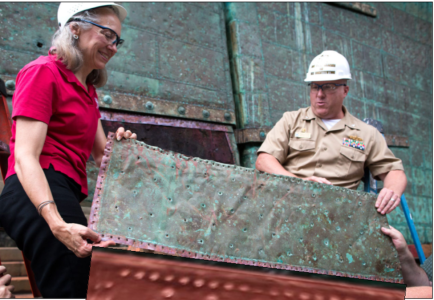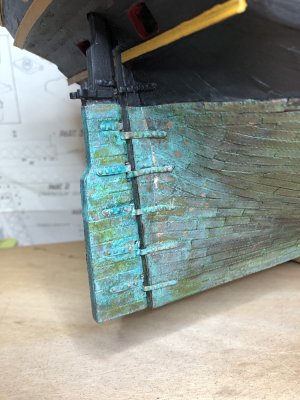-

Win a Free Custom Engraved Brass Coin!!!
As a way to introduce our brass coins to the community, we will raffle off a free coin during the month of August. Follow link ABOVE for instructions for entering.
You are using an out of date browser. It may not display this or other websites correctly.
You should upgrade or use an alternative browser.
You should upgrade or use an alternative browser.
Patina - Hull plates
- Thread starter Stuart Little
- Start date
- Watchers 11
Makes one wonder what it does to your insides! Another idea, wonder what Coke would do, as it's good for freeing off seized enginesInteresting, I may have found a use for the bottle of Worcestershire sauce which has been in my cupboard for years!



Worcestershire Sauce is the winner.
Ammonia and salt fumes seems to be the go-to route on current videos to create a greenish blue patina like those we see on ships with copper bottoms.
Example from USS Constitution regarding the color is below. A video for making large pieces follows, but for our purposes a small plastic container and lid would be about the right size.
Compare the colors on the video with the actual plates from the ship below.
Allan
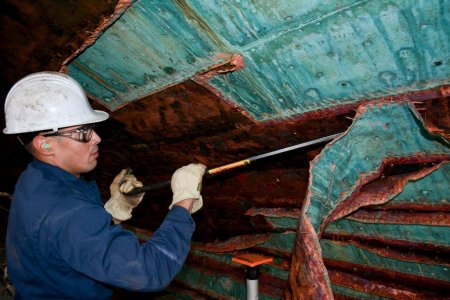
Example from USS Constitution regarding the color is below. A video for making large pieces follows, but for our purposes a small plastic container and lid would be about the right size.
Compare the colors on the video with the actual plates from the ship below.
Allan

x
Last edited:
You are probably right but why is the copper plating on the USS Constitution green after being in the water? Same for the plates on HMS Victory (picture below) I did a quick search but the only things I could find are summarized as follows:Copper turns green when exposed to air, not while it's submerged
Copper turns green when exposed to salt water due to the patina formation process. The green color is a result of copper reacting with oxygen, moisture, and chloride (from the salt) to form copper chloride, copper sulfate, and copper carbonate compounds.
Allan
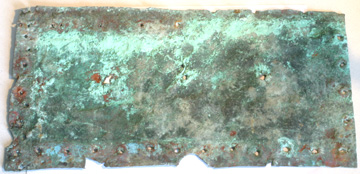
x
Last edited:
Jerry, Everything I'm seeing on the web indicates that salt water will cause oxidation of copper plating.Exposure to the air after being submerged in saltwater caused oxidation.
I spray freshwater and wipe off the bottom of my model when it comes out of the water. Where I missed, you'll see green.
If Victory's green, it's because they made it that way artificially. Cutty Sark isn't green, she brown, like a old penny.
I would imagine that you are not getting it because you rinse with fresh and then dry it off.
x
Last edited:
Cutty Sark's copper isn't green, it's brown, like an old penny.
Cutty Sark's sheathing isn't copper. It's Muntz metal, a type of brass alloy comprised of 60% copper, 40% zinc, and trace amounts of iron. The process of creating it is also quite unique since Muntz metal is manufactured by melting copper first and then introducing zinc and trace amounts of iron. George Fredrick Muntz, an English businessman from Birmingham, England, developed the metal in the 1830s. It was much less subject to corrosion than the copper sheathing used previously and became popular as a superior material for combatting the ravages of marine borers. It's slow oxidation rate yields a "copper penny brown" color, unlike the verdigris green seen on pure copper.
Muntz metal is "brass colored" yellow metal, unlike copper which is "copper colored." Kit's which provide "real copper plates" to sheath Cutty Sark are technically incorrect.
Cutty Sark's accurate Muntz metal sheathing when new following her most recent restoration:
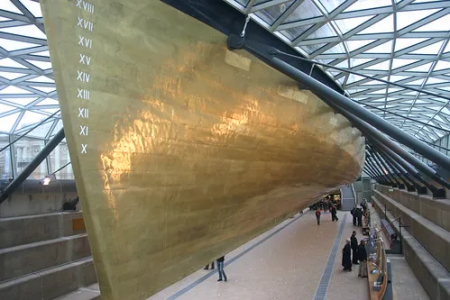
Last edited:
I’ll beg to differ with you on that point, Jerry. While that may hold true in small, still bodies of water, out on the open ocean there is more than enough wave action to ensure thorough oxygenation of seawater to a significant depth.I imagine so since that's what I said. Except oxidation requires oxygen, of which there isn't enough underwater to turn the copper green.
After reading further, I think Namabiiru has it right, there is enough dissolved oxygen in seawater to cause oxidation of copper sheathing, although the process is slower compared to exposure in air.
Allan
That's correct, guys. On copper sheathed hulls, there will always be a "reverse bathtub ring" of blue-green oxidized copper around the waterline's "splash zone." It doesn't extend very far below the waterline, though. When copper sheathed hulls are hauled out, they are, of course, fouled with growth. When the fouling is power-washed off before drying significantly, the previously submerged copper will be "old penny brown" initially. It will thereafter turn blue-green as the air causes the copper to oxidize in a fairly short time. This is, as far as I know, a salt water phenomenon. I don't have any experience with copper sheathed hulls in fresh water. I believe it's the salt that causes the blue-green color.
You're gonna do what you "like" regardless, so go ahead and slap lime green paint on her, tie up those crows-feet to her tops, and cover her in pirate flags, may as well stitch anchor cable sized lines in her sails too - that'll make it look "salty."
This topic seems to have about run its course, but I would offer up one thought that seems to have been overlooked. It seems logical to me that an RC ship that is typically viewed in the water would have the appearance of a ship in water. A non-RC ship (assuming it won’t be going into a saltwater aquarium) is most likely going to be displayed in the open air. Therefore, why not display it as it would appear in the open air? I know; someone will say, “then you are not allowed to show her with sails unfurled.” To that I say, “psshah!”
- Joined
- Oct 9, 2020
- Messages
- 2,157
- Points
- 488

Hi JerryYou're gonna do what you "like" regardless, so go ahead and slap lime green paint on her, tie up those crows-feet to her tops, and cover her in pirate flags, may as well stitch anchor cable sized lines in her sails too - that'll make it look "salty."
Wow. Did pirate ships have coppered bottoms?
Allan
That's what copper sheathing looks like after it's been in the air for a while. She was drydocked for some time to do below the waterline repair work. If somebody wants to model a copper sheathed hull, out of the water, it should look like this. The sheathing was never "new penny shiny" by the time the bottom was sheathed and the vessel ready for launch. In the salt air of the waterfront, copper goes green pretty quickly.I don't know if this is helpful or not, but I use a combination of vinegar and salt to get the patina. I made the assumption that the verdigris was everywhere, as per this photo of the Consitution:
View attachment 538890






